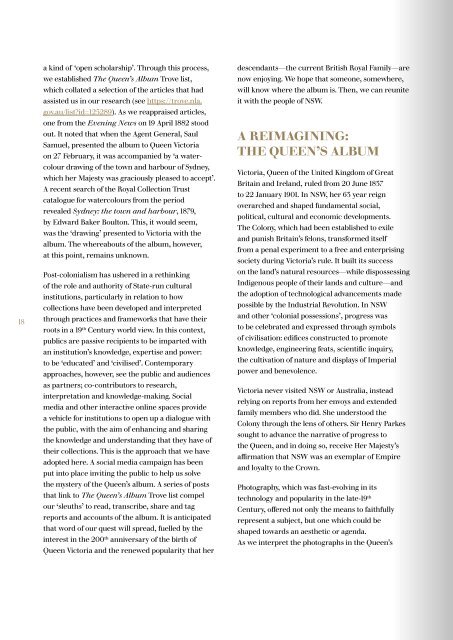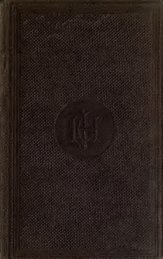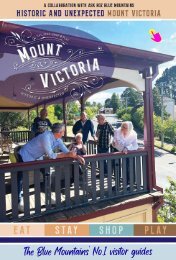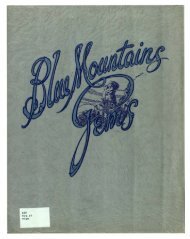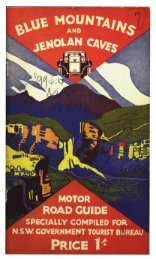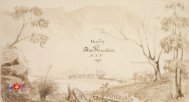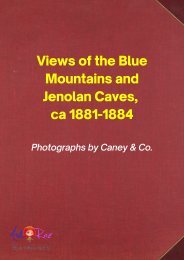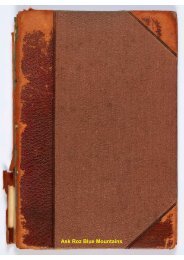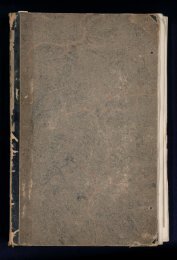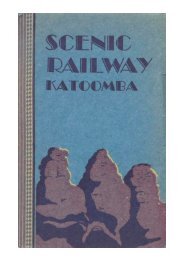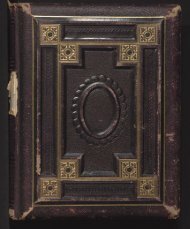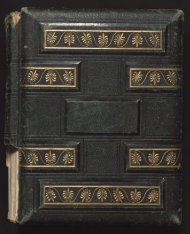The Queen's Album
The Queen’s Album explores the unique story of an album of photographs gifted to Queen Victoria at Windsor Castle in 1882 on behalf of the people of NSW. In 2018, this photograph album was identified as the original prototype of an album presented to Queen Victoria at Windsor Castle in 1882. On Friday 17 December 1880, the Sydney Morning Herald announced that a large album of photographs had been produced by the Government of NSW to be presented to Her Majesty the Queen on behalf of the people of the colony. Described as a ‘marvel of sumptuous binding’ in purple velvet, the cover was decorated with the royal monogram in richly chased silver, and its corners were protected by elaborate silver scroll work. Containing 56 ‘unusually large’ photographs depicting the choicest scenes of ‘city, harbour, mountain, river, and spreading plain’, it was created to give Her Majesty ‘a favourable idea of one of the greatest of her Colonial dependencies’. Despite the hype and excitement surrounding its production, the Queen’s Album would not leave the colony for at least another year. In December 1881 the NSW Government Printer Thomas Richards finally received instructions to forward the album to the NSW Agent General Saul Samuel in London. The album – now with a ruby red velvet cover and eight additional photographs – was presented to Queen Victoria on 27 February 1882. The Queen recorded the event in her diary, noting that the album, ‘a present from the Colony, is very pretty’. Unfortunately, the current whereabouts of this album is unknown.
The Queen’s Album explores the unique story of an album of photographs gifted to Queen Victoria at Windsor Castle in 1882 on behalf of the people of NSW.
In 2018, this photograph album was identified as the original prototype of an album presented to Queen Victoria at Windsor Castle in 1882. On Friday 17 December 1880, the Sydney Morning Herald announced that a large album of photographs had been produced by the Government of NSW to be presented to Her Majesty the Queen on behalf of the people of the colony.
Described as a ‘marvel of sumptuous binding’ in purple velvet, the cover was decorated with the royal monogram in richly chased silver, and its corners were protected by elaborate silver scroll work. Containing 56 ‘unusually large’ photographs depicting the choicest scenes of ‘city, harbour, mountain, river, and spreading plain’, it was created to give Her Majesty ‘a favourable idea of one of the greatest of her Colonial dependencies’.
Despite the hype and excitement surrounding its production, the Queen’s Album would not leave the colony for at least another year. In December 1881 the NSW Government Printer Thomas Richards finally received instructions to forward the album to the NSW Agent General Saul Samuel in London.
The album – now with a ruby red velvet cover and eight additional photographs – was presented to Queen Victoria on 27 February 1882. The Queen recorded the event in her diary, noting that the album, ‘a present from the Colony, is very pretty’.
Unfortunately, the current whereabouts of this album is unknown.
You also want an ePaper? Increase the reach of your titles
YUMPU automatically turns print PDFs into web optimized ePapers that Google loves.
18<br />
a kind of ‘open scholarship’. Through this process,<br />
we established <strong>The</strong> Queen’s <strong>Album</strong> Trove list,<br />
which collated a selection of the articles that had<br />
assisted us in our research (see https://trove.nla.<br />
gov.au/list?id=125289). As we reappraised articles,<br />
one from the Evening News on 19 April 1882 stood<br />
out. It noted that when the Agent General, Saul<br />
Samuel, presented the album to Queen Victoria<br />
on 27 February, it was accompanied by ‘a watercolour<br />
drawing of the town and harbour of Sydney,<br />
which her Majesty was graciously pleased to accept’.<br />
A recent search of the Royal Collection Trust<br />
catalogue for watercolours from the period<br />
revealed Sydney: the town and harbour, 1879,<br />
by Edward Baker Boulton. This, it would seem,<br />
was the ‘drawing’ presented to Victoria with the<br />
album. <strong>The</strong> whereabouts of the album, however,<br />
at this point, remains unknown.<br />
Post-colonialism has ushered in a rethinking<br />
of the role and authority of State-run cultural<br />
institutions, particularly in relation to how<br />
collections have been developed and interpreted<br />
through practices and frameworks that have their<br />
roots in a 19 th Century world view. In this context,<br />
publics are passive recipients to be imparted with<br />
an institution’s knowledge, expertise and power:<br />
to be ‘educated’ and ‘civilised’. Contemporary<br />
approaches, however, see the public and audiences<br />
as partners; co-contributors to research,<br />
interpretation and knowledge-making. Social<br />
media and other interactive online spaces provide<br />
a vehicle for institutions to open up a dialogue with<br />
the public, with the aim of enhancing and sharing<br />
the knowledge and understanding that they have of<br />
their collections. This is the approach that we have<br />
adopted here. A social media campaign has been<br />
put into place inviting the public to help us solve<br />
the mystery of the Queen’s album. A series of posts<br />
that link to <strong>The</strong> Queen’s <strong>Album</strong> Trove list compel<br />
our ‘sleuths’ to read, transcribe, share and tag<br />
reports and accounts of the album. It is anticipated<br />
that word of our quest will spread, fuelled by the<br />
interest in the 200 th anniversary of the birth of<br />
Queen Victoria and the renewed popularity that her<br />
descendants—the current British Royal Family—are<br />
now enjoying. We hope that someone, somewhere,<br />
will know where the album is. <strong>The</strong>n, we can reunite<br />
it with the people of NSW.<br />
A REIMAGINING:<br />
THE QUEEN’S ALBUM<br />
Victoria, Queen of the United Kingdom of Great<br />
Britain and Ireland, ruled from 20 June 1837<br />
to 22 January 1901. In NSW, her 63 year reign<br />
overarched and shaped fundamental social,<br />
political, cultural and economic developments.<br />
<strong>The</strong> Colony, which had been established to exile<br />
and punish Britain’s felons, transformed itself<br />
from a penal experiment to a free and enterprising<br />
society during Victoria’s rule. It built its success<br />
on the land’s natural resources—while dispossessing<br />
Indigenous people of their lands and culture—and<br />
the adoption of technological advancements made<br />
possible by the Industrial Revolution. In NSW<br />
and other ‘colonial possessions’, progress was<br />
to be celebrated and expressed through symbols<br />
of civilisation: edifices constructed to promote<br />
knowledge, engineering feats, scientific inquiry,<br />
the cultivation of nature and displays of Imperial<br />
power and benevolence.<br />
Victoria never visited NSW or Australia, instead<br />
relying on reports from her envoys and extended<br />
family members who did. She understood the<br />
Colony through the lens of others. Sir Henry Parkes<br />
sought to advance the narrative of progress to<br />
the Queen, and in doing so, receive Her Majesty’s<br />
affirmation that NSW was an exemplar of Empire<br />
and loyalty to the Crown.<br />
Photography, which was fast-evolving in its<br />
technology and popularity in the late-19 th<br />
Century, offered not only the means to faithfully<br />
represent a subject, but one which could be<br />
shaped towards an aesthetic or agenda.<br />
As we interpret the photographs in the Queen’s


